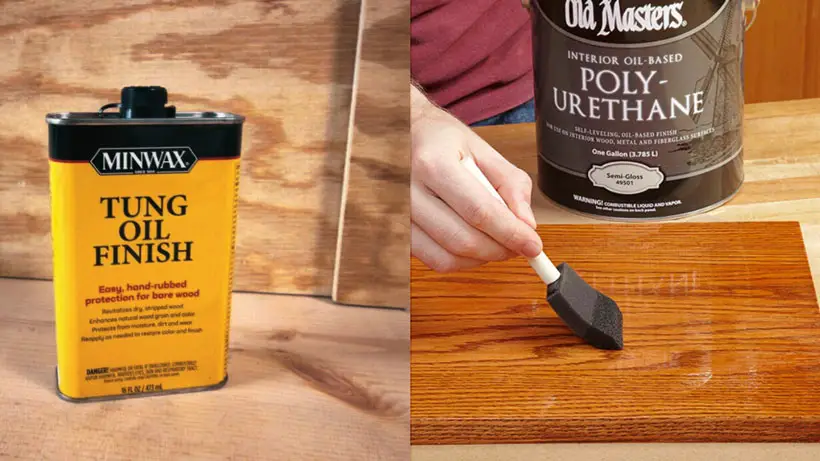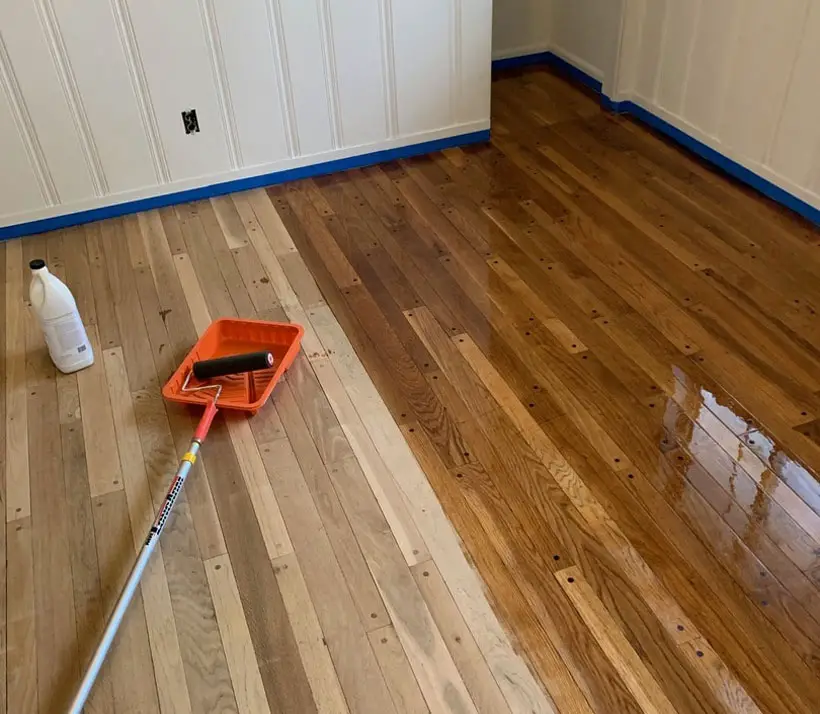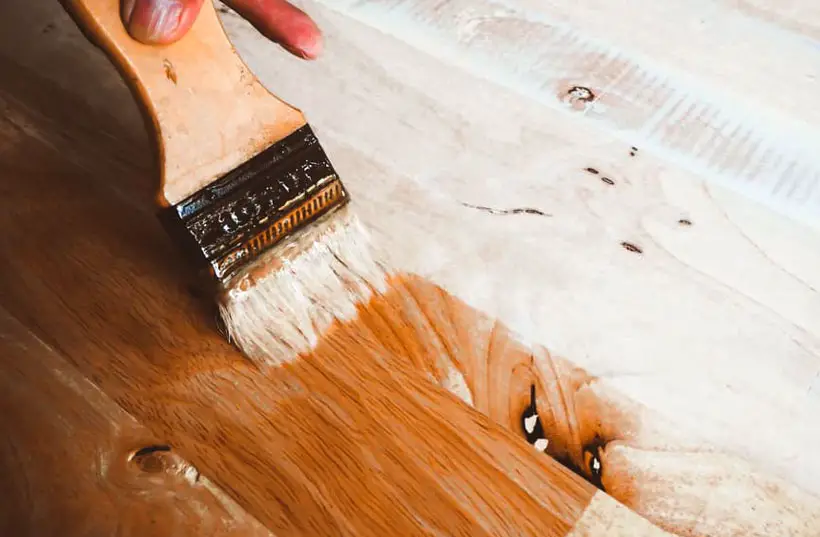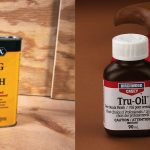Tung Oil vs Polyurethane – Which One Should I Choose?
After making a wooden appliance, it surely needs a moisture and water-resistant finishing. For this reason, a protection layer of varnishes like Tung oil or polyurethane would be used.
But what is the difference between tung oil vs Polyurethane? Tung oil is a natural furnishing oil derived from the seeds of the tung tree (Vernicia fordii). Conversely, polyurethane is a synthetic polymer (liquid plastic). Usually, both of them are commonly used as protective coatings or finishes for various surfaces. But their overall effectiveness and applications vary more or less.
We intend to highlight the contrasts between Tung oil and polyurethane. We will also provide a clear idea about their uses and other related important stuff. Hence, let’s read through.
Tung Oil vs Polyurethane – Which One Should I Choose?
A coating or finish to wood enhances its beauty, improves its durability, and protects it from environmental factors. That is, furnishing helps to extend the lifespan of a component. It also ensures the long-term usability of furniture. Usually, Tung oil or polyurethane is used for this.

However, tung oil is a natural substance, while polyurethane is a laboratory-made component. So, there are significant differences between the finishing done with tung oil and polyurethane. Nonetheless, both are very important for protecting our precious collections.
Tung Oil Finishes Significant Components
Tung oil is an eco-friendly finish. However, before deciding on a finish, you need to consider its other properties. Consequently, the following are some important tung oil finish components:

Composition of Tung Oil finish
The Tung oil finish is made from tung oil itself. Tung oil can be collected from the seeds of tung trees. Usually, pure tung oil is free of any additives or additional solvents.
Application Method of Tung Oil Finish
Tung oil is commonly applied by rubbing or brushing it onto the wood surface. It penetrates the wood and requires multiple coats for effective protection. The details have been discussed in a step-by-step manner.
Step 1: Prepare and thoroughly clean the surface.
Step 2: Thin the oil with a solvent such as citrus solvent.
Step 3 – Use a generous amount and properly apply the first coat.
Step 4 – Wait approximately 40 minutes. Apply the second coat after ensuring that the first layer has been thoroughly absorbed.
Step 5 – After several treatments, the surface was no longer absorbent. A rug can be used to remove excess oil.
Step 6 – Allow the surface to heal for about a month.
Here’s a YouTube video to help you:
Appearance after Application of Tung Oil
Tung oil gives a natural, low sheen or matte finish. It enhances the wood’s natural beauty, deepens its color, and emphasizes the grain.
Protection and Durability
Tung oil offers mediocre protection against stains, dampness, and scratches. That is, it is not the strongest finish in this regard.
However, pure tung oil and tung oil finish are not the same. The finish made from tung oil contains artificial substances for protection while pure tung oil does not. Thus, pure tung oil is way weaker than tung oil varnish. Tung oil is also more powerful than some other finishes such as linseed oil.
Maintenance
Periodic maintenance and reapplication of tung oil may be necessary. It does not require substantial sanding and may be simply rejuvenated by applying another layer of tung oil.
Environmental Considerations
Tung oil is a plant-derived product. So, naturally, it is eco-friendly. Conversely, synthetic finishes like polyurethane contain harmful compounds. These also include the most concerning volatile organic compounds (VOCs).
Polyurethane Finishes Significant Components
Polyurethane is one of the strongest varnishes available in the market. Naturally, due to its popularity, people tend to purchase it a lot. However, before choosing, it’s crucial to understand the pros and cons of this varnish.

Composition of Polyurethane
Polyurethane is a chemically made synthetic polymer. It is mainly a composition of polyols and isocyanates. It might contain some additives and solvents.
Application Method of Polyurethane
You can apply the polyurethane finish as a liquid coating of plastic. The tools required for application are mainly a brush, roller, or sprayer.
Here’s a YouTube video to assist you with this:
Appearance after Application of Polyurethane
Various finishes are available for polyurethane, including high gloss, satin, and matte. It alters the appearance of the wood by producing a clear, firm, and often shiny surface.
Protection and Durability
Polyurethane finish exhibits excellent durability. It is mainly applied on the surface of wood. After the coating, it would form a liquid plastic barrier. This barrier prevents any moisture from getting into the wood.
Polyurethane barrier also prevents the home appliances cleaning products from entering the furniture. Some polyurethane finishes are even UV resistant.
Maintenance
In most cases, polyurethane finishes need less maintenance than natural ones. However, some refinishing might be required. Often, only a reapplication or sanding is enough for a long time.
Environment-Related Issues
Certain polyurethane coatings contain dangerous elements like high amounts of VOCs. During the application, it might cause air pollution and pose health risks. Nevertheless, there are also some eco-friendly polyurethane such as water-based polyurethane.
When Should You Use Tung Oil?
You could use tung oil to give your furnishings a more aesthetic look. Tung oil is typically used on antiques and expensive furniture.
It produces a smooth finish and highlights the color and texture of the wood, and unlike polyurethane, you can rely on tung oil to offer a top layer that is absolutely clear.
Due to its strength and non-toxicity, it is used on cutting boards and other kitchenware in addition to furniture.

When Should You Use Polyurethane?
Polyurethane varnish is used for many surfaces, like protecting hardwood floors, stairwells, tabletops, doors, window frames, cabinets, and wood furnishings.
Similarly, Polyurethane finishes are widely chosen for almost all outdoor furnishings due to their water-resistant, heat-resistant, and durability features. In other words, choose a polyurethane coating if you require a lasting finish.
Tung Oil vs Polyurethane – Costing
Usually, a plant-based product would be pricier than a chemically made product. Thus, you can guess that tung oil is expensive compared to polyurethane.
However, it is not the sole reason for this cost difference. We ought to let you know the other reasons behind it.
- Raw materials: The tung tree is only found in certain areas of China and South America. Thus, compared to lab-made polyurethane, it is extremely rare.
- Manufacturing Process: Polyurethane is made in the lab. The raw materials of polyurethane are chemically made products. Conversely, the raw material of tung oil is scarce. Thus, the production of tung oil is also limited.
- Rarity and demand: In the market, you can find many brands and formulations of polyurethane. But tung oil, especially high-quality tung oil, is very limited.
Tung Oil vs Polyurethane – Time for Drying and Curing
Tung oil takes more time to dry than polyurethane. One single coat of tung oil almost takes two to three days or 48-72 hours to dry completely. Also, you cannot apply another layer of tung oil before the previous one completely dried off. Usually, you need to apply five to seven coats of tung oil to complete the finish.

In this perspective, polyurethane is quicker. Generally, a coat of water-based polyurethane takes only an hour to semi-dry. For oil-based polyurethane, the time is five to six hours.
Also, you can put a new layer on a semi-dry polyurethane coating.
If you’re comparing the differences between tung oil and polyurethane finishes, our article on can you put polyurethane over shellac might provide insights that could help you make informed decisions for your finishing needs. Moreover, if you’re curious about using polyurethane over surfaces previously finished with lacquer, our guide on can you put polyurethane over lacquer considerations is here to offer guidance. We understand the importance of achieving the best finishes and addressing specific application scenarios, and our comprehensive resources are designed to help you navigate and make informed choices for your woodworking projects.FAQs
We have tried to address some common topics related to tung oil and polyurethane. Have a look.
Q: Is it okay to combine tung oil and polyurethane?
Absolutely not; do not combine these two finishes. Poly can be used after tung oil, but not the other way around. Additionally, mixing these finishes would result in a viscous mess. This mixture of finishes would most likely flake up or peel if left on a wood surface.
Q: Does tung oil have a waterproof feature?
No, pure tung oil does not make wood waterproof. However, a combination of oil varnish with tung oil can make the wood somewhat waterproof. The wood does not, however, completely become waterproof.
Q: How long does it take for polyurethane to cure when using tung oil?
This procedure can take up to six months. However, polyurethane needs 12 to 18 months to fully harden after being cured. This implies that the polyurethane product can still be used in conjunction with wood flooring and tung oil.
Last Words
Tung oil or polyurethane – the choice greatly depends on the user and products. For antics, tung oil is a must-have finish and cannot be replaced by polyurethane. While for normal furnishes, polyurethane varnish is greatly favored. Polyurethane could be an excellent choice for our everyday furnishings.
However, it contains toxic substances. But tung oil is one of the strongest non-toxic plant-based finishes. You’ve also learned how to correctly apply tung oil and polyurethane. Above all, the user should consider the preferred durability, cost, and placement of the furnishes before choosing the right one.





